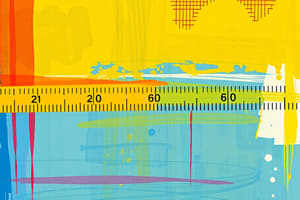Podcast
Questions and Answers
Which type of validity indicates that an instrument appears to test what it is supposed to test?
Which type of validity indicates that an instrument appears to test what it is supposed to test?
- Construct validity
- Criterion-related validity
- Face validity (correct)
- Content validity
Which type of validity reflects the degree to which the items in an instrument adequately reflect the content domain being measured?
Which type of validity reflects the degree to which the items in an instrument adequately reflect the content domain being measured?
- Face validity
- Content validity (correct)
- Construct validity
- Criterion-related validity
Which type of validity involves the degree to which the outcomes of one test correlate with outcomes on a criterion test (GOLD STANDARD)?
Which type of validity involves the degree to which the outcomes of one test correlate with outcomes on a criterion test (GOLD STANDARD)?
- Content validity
- Criterion-related validity (correct)
- Construct validity
- Face validity
Which type of validity relates to the degree to which a theoretical construct is measured by an instrument?
Which type of validity relates to the degree to which a theoretical construct is measured by an instrument?
What is the relationship between validity and reliability?
What is the relationship between validity and reliability?
What does content validity measure?
What does content validity measure?
Which type of validity predicts some future performance?
Which type of validity predicts some future performance?
What does face validity indicate?
What does face validity indicate?
What is the degree to which a theoretical construct is measured by an instrument related to?
What is the degree to which a theoretical construct is measured by an instrument related to?
What is the reliability coefficient value that indicates good reliability?
What is the reliability coefficient value that indicates good reliability?
Which type of reliability is based on repeated administration of a test to the same individuals over a specific time interval?
Which type of reliability is based on repeated administration of a test to the same individuals over a specific time interval?
What is an example of a consideration for test-retest reliability?
What is an example of a consideration for test-retest reliability?
Which type of reliability focuses on the degree to which one rater can obtain the same ratings on multiple occasions of measuring the same variable?
Which type of reliability focuses on the degree to which one rater can obtain the same ratings on multiple occasions of measuring the same variable?
What does a reliability coefficient of less than 0.5 indicate?
What does a reliability coefficient of less than 0.5 indicate?
Which type of reliability involves the reliability of two equivalent forms of a measuring instrument?
Which type of reliability involves the reliability of two equivalent forms of a measuring instrument?
What is an example of a consideration for rater reliability?
What is an example of a consideration for rater reliability?
What is the reliability coefficient value that indicates moderate reliability?
What is the reliability coefficient value that indicates moderate reliability?
Which type of reliability focuses on the degree to which two or more raters can obtain the same ratings for a given variable?
Which type of reliability focuses on the degree to which two or more raters can obtain the same ratings for a given variable?
Flashcards are hidden until you start studying
Study Notes
Types of Validity
- Face Validity: Indicates whether an instrument appears to assess what it is designed to measure from a superficial standpoint.
- Content Validity: Reflects how well the items in an instrument represent the entire content domain being evaluated.
- Criterion Validity: Measures the correlation between the outcomes of a test and a criterion test or gold standard, showing how well one test predicts another.
- Construct Validity: Relates to how effectively a tool measures a theoretical construct, assessing the underlying concept it is intended to measure.
- Predictive Validity: Predicts future performance based on the scores of a test, indicating how well the test can forecast outcomes.
Validity vs. Reliability
- Validity and reliability are interrelated; an instrument can be reliable (consistent results) without being valid (accurate measurement of the intended variable).
Reliability Coefficients
- Good Reliability: A reliability coefficient value of 0.7 or higher typically indicates good reliability.
- Moderate Reliability: A reliability coefficient value between 0.5 and 0.7 suggests moderate reliability.
- Reliability Coefficient Less than 0.5: Indicates poor reliability, suggesting the test may not consistently measure what it intends to.
Types of Reliability
- Test-Retest Reliability: Assessed through repeated administration of the same test to the same individuals across a specified time interval, evaluating consistency over time.
- Consideration Example: Time gap between tests must be suitable to avoid memory effects.
- Inter-Rater Reliability: Measures consistency between different raters evaluating the same variable.
- Consideration Example: Training raters to ensure they understand scoring criteria limits variability.
- Parallel-Forms Reliability: Evaluates the consistency of two equivalent forms of a measuring instrument, ensuring they yield similar results.
Additional Concepts
- Inter-Rater Reliability focuses on achieving similar ratings from multiple raters on the same variable, ensuring measurement consistency across different evaluators.
Studying That Suits You
Use AI to generate personalized quizzes and flashcards to suit your learning preferences.




